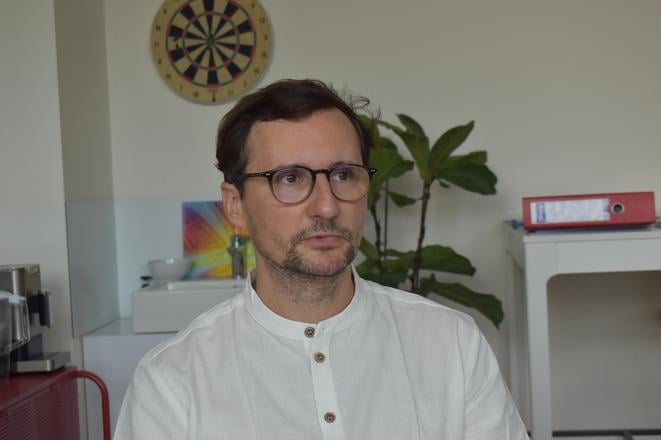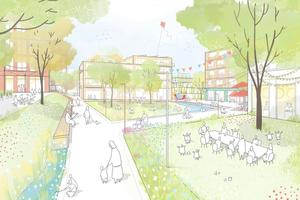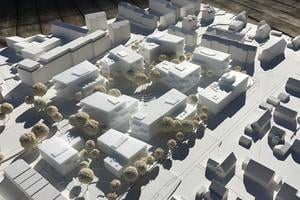Rudolf Kozlai comes from Prešov. He began studying architecture in Prague, Czechia, but completed his studies in Graz, Austria. He previously worked in Portugal and is now based in Germany, where he is the project leader for the construction of a new housing estate that will have a completely different character from what is usual in Slovakia.
Kozlai is the co-founder of the Prešov-based Urbanika association, which has undertaken several architectural projects in the eastern Slovak town. He is considered an expert in design and art with a strong sense of technical solutions.
You currently work in Berlin and are the project manager of a new housing estate in Stuttgart, Germany.
Yes, it's basically an urban neighbourhood with 10 buildings. Family houses on two sides, and apartment buildings on the other two.
Is it being constructed on the site of a former housing estate, or is it a completely new development?
There was once a housing estate standing there, built after World War II, but it no longer corresponded to the investors' - two cooperatives actually who own them - ideas either in terms of size or intention. They decided to replace them, announced an architectural competition, and the whole thing is part of the IBA 2027 International Architecture Exhibition. It does not only concern Stuttgart, but also its wider surroundings.
This exhibition has been running for 100 years, and its projects are actually implemented. What kind of exhibition is it?
The goal of the competition is to develop urban planning in German cities. Germany came up with the concept of Internationale Bauausstellung, or IBA for short. One very famous exhibitions took place in 1927 in Stuttgart. Many internationally known architects of the time were involved in it. The aim is to actually build something and then test it in practice. Our project is called Quartier am Rotweg, that is the Rotweg City Quarter, named after one of the main streets there.
What stage is the project at now?
We are obtaining building permits, and at the same time we are also processing implementation projects for the first buildings. Construction is expected to start in mid-October, with the next building starting in January. If all goes well, the first residents could live there in 2026.
How long have you been working on this project?
Since April 2021. Then in September 2021, I became the project lead and I've been there since then, I participate mainly in urban planning, but also in building designs and coordination with other studios that are also involved.
The housing is intended to be more community-focused and ecological. Can you tell us more about that?
The project stems from three main criteria of resistance. Firstly, it is ecological resistance, meaning not to increase the climatic burden. Secondly, it is about increasing the resilience of the community. It is not so much about the architecture itself, but about how people live together to create a stronger community. And thirdly, it is resistance to external influences, whether it is a pandemic or new forms of work associated with it. We offer several job opportunities within the entire neighbourhood. There are flexible options for renting space, co-working, even some small business. We also have smaller community spaces that you can rent to celebrate a birthday or a wedding.
It sounds like a return to communal walkway flats but in a more modern form. How should we imagine it?
The communal walkway flats are in nine of the ten buildings, from the first above-ground floor. One of the buildings does not have this system, it works on a different principle. I know that in Slovakia the system is mostly connected with some kind of social housing, it is also similar in Germany. But we wanted to orient life from flats to walkways. The buildings have funny names. One is named Zidane; it doesn't have balconies, but it has very deep walkways, basically terraces. When someone walks into a flat, the living room faces the walkway. So the walkway is not just a simple corridor which we have to pass to get to the flat, but it also has this relaxing character.
What types of flats will be available?
In addition to one- to five-room ones, there are also flats that we tried to make special with various architectural and spatial elements. For example, we have flexible rooms that can be attached to larger ones with sliding elements. So you can have a room that is normally part of the living room and then you can separate it. For example, when your grandma comes to visit to take care of the children. This is one way. Another way is co-living. That is, when several people live together in one flat. In this scenario, there are several ways it can work. Either you have a room with a private bathroom attached to it and areas such as kitchen and living room are shared, or there is Wohngemeinschaft, the most common concept in Germany, which means shared social facilities.
There are also micro-apartments for visitors.
It is called Gästewohnung, or a guest flat. Zidane has five such flats, which you can rent when a visitor comes. Perhaps your sister or brother with their family come to visit you, then can rent them and you daily life will not be disturbed because of this.
Is such a project transferable and feasible in Slovakia? For example, in Prešov or Košice?
It is feasible, but it is rather connected with people's mindset, whether they are willing to accept such forms of living at all. Within Stuttgart, we are targeting communities that want to live more exposed and do not have a problem with the fact that other residents will pass by in front of their walkway. As part of our market research, we have already visited various buildings in Berlin, Zurich and Vienna, where such communities already exist and function, so we know that it can work. Can it be transferred to Slovakia? Yes, you just need to find a community of people who would accept it. In my opinion, it has a chance to even become addictive in some way, when people see that it is of quality, it helps them, they don't feel so alone. I can go outside and talk to my neighbour, not just crawl into my own apartment.
How did you end up in Berlin?
It was quite interesting. I was invited by a friend with whom I worked in Lisbon, Portugal.
Germans are said to be precise. Is this true in architecture as well?
It is. In a way they try to break free from it a bit, but all the laws and standards push them to a great degree of precision.
Is it at the expense of creativity?
In order for creativity to arise, some norms and laws simply have to die. It cannot be done otherwise. One must re-interpret it and always try not only to grind it down, but to look for boundaries of those laws, and above all their meaningfulness. It must be meaningful, because sometimes a law is too broad-minded, or let's say a sentence in it covers too wide a spectrum and does not take into account the subtleties and small differences.
What did you work on in Berlin?
Even before coming to Berlin I was quite involved in schools. It is my favourite topic, how children will be taught in the future and how the pedagogy will be transformed into a spatial arrangement. I also worked on office buildings, and some family houses.
Can you see yourself returning to Slovakia?
It's always a possibility, so we'll see.
When you return after a long time, how do you perceive Slovak towns?
I'm going to talk about Prešov, since it is my city, I like it. Every time I come, I'm interested in what's new, where something new is being built, I even watch it from abroad. I'm glad it is getting a little closer to the West by making bike paths. Buildings are being added. I also notice halls or family houses.
Is Prešov changing, or is it stagnating?
The pace is slower compared to Berlin, but yes, it is changing. The changes become more visible over time. While everyday life in Prešov might seem slow, the town has potential. It's a lovely green town, albeit a bit small.
©Korzár

 Architect Rudolf Kozlai. (source: Michal Frank)
Architect Rudolf Kozlai. (source: Michal Frank)


